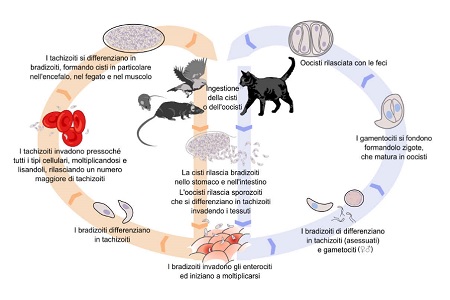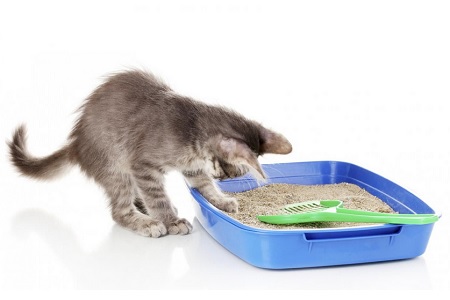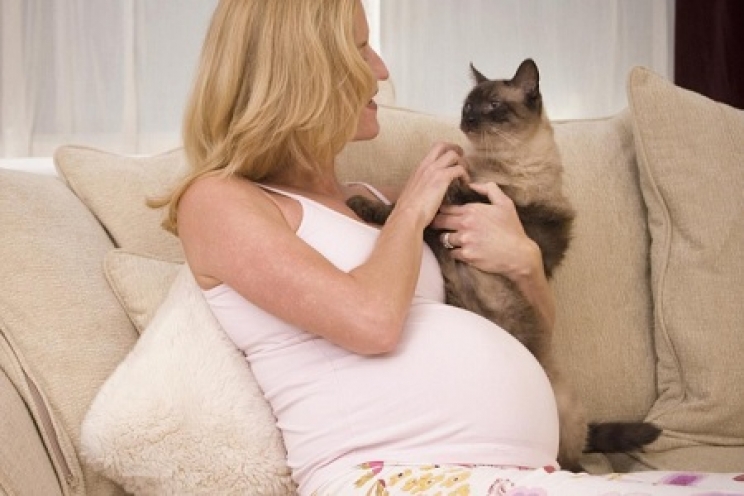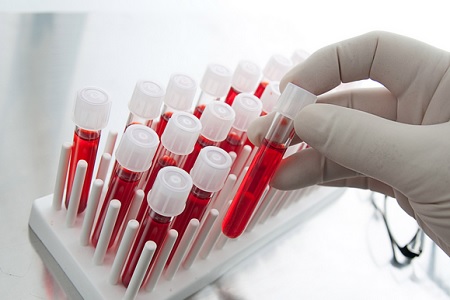Too often cats become the unfortunate and unaware victims of misinformation about toxoplasmosis, a nasty disease that can cause serious harm in pregnant women. In fact, many families abandon or leave their beloved cat before pregnancy or when the baby arrives because of this. But this unhappy decision is not absolutely necessary: let's find out why.
What is toxoplasmosis?
As we have widely discussed in the article entirely dedicated to the topic (you can consult it by clicking on this link), toxoplasmosis is a parasitic infectious disease caused by a protozoa, called Toxoplasma gondii. We will try to simplify the behavior of this small parasite as much as possible.

The cat eliminates the "eggs" of Toxoplasma contained inside the feces in the litter, in the garden or in the fields. These "eggs" are not yet dangerous, but after about 24-48 hours they are, at a temperature of about 24 ° C and with high humidity. After this period of time, if they are ingested by man, other cats, dogs, mice, birds and animals in general they arrive in the intestine, they hatch and end up in the blood. From here they manage to travel to different locations, among which the most important are the muscles, but sometimes they manage to reach the eyes, brain, heart, liver or lungs. Once they have settled in a location, they incorporate into a protective cyst. When the cat hunts a small prey containing these cysts, even if we offer him contaminated raw meat, he will also clearly take on the parasite, which will be able to reproduce itself until it produces and eliminates new "eggs". This is how the cycle starts again.
What causes this parasite in the body?
In most cases absolutely nothing, both in humans and in animals. At most, we might feel tired, exhausted and perhaps with a little diarrhea and fever, but nothing more. On the other hand, if we talk about people or animals whose immune system is not strong enough, the consequences can be more serious, with the presence of encephalitis, epilepsy, vestibular syndrome or eye inflammations - uveitis in cats, chorioretinitis in humans – lungs, heart and liver problems.
What are the risks in pregnancy? 
Pregnant women is also an important topic. In fact, Toxoplasma gondii is able to cross the placenta until it reaches the fetus. In these cases it can cause different consequences depending on the period of gestation. In short words, the first six months are the most critical period for the fetus, which does not yet have adequate defenses to prevent the parasite from colonizing and damaging it.
The consequences range from abortion or children with serious neurological malformations. Among these, the main consequences are blindness, mental retardation, epilepsy. As you approach the end of pregnancy, however, the chances of the baby being born healthy increases.
However, it must be considered that, if the consequences for the fetus are greater in the early and mid-pregnancy, the risk that Toxoplasma gondii will actually manage to infect is minor. In short words, in the first few months it is more difficult for the parasite to reach the fetus, but if it manages to do so, the consequences would be very serious. On the contrary, in the last three months it can more easily infect it, but it is no longer so dangerous.
How to avoid toxoplasmosis
We now come to the most important point. Too many myths and urban legends are circulating about toxoplasmosis, particularly about proximity to cats. We think of the hundreds of women who, as soon as they discover they are having a baby, send away the much loved pet forever. Of course, the fear of pregnancy is absolutely understandable, but the only thing you really need is a correct and scientific information about this disease.
We think that the chances of the cat being able to transmit the infection to humans are very low. Let's explain why:
-
 Cats that contract the parasite, host it only for short periods of time and eliminate the "eggs" with the feces for 1-2 weeks at most, often not even every time they poop. After that, they naturally become resistant to infection and will no longer eliminate them;
Cats that contract the parasite, host it only for short periods of time and eliminate the "eggs" with the feces for 1-2 weeks at most, often not even every time they poop. After that, they naturally become resistant to infection and will no longer eliminate them; -
Especially if we are talking about stray cats, it is likely that they have already contracted toxoplasmosis in the past, so they will no longer produce "eggs" in the future;
-
The "eggs" of Toxoplasma gondii, once expelled with feces, become dangerous only after 24-48 hours and those who live with a cat hardly leave the litter dirty for more than a whole day;
-
In order to take the "eggs", you should clean the litter box (after leaving it unkempt for more than 24 hours) and then, without washing your hands, you should touch your lips, eat your nails or start cooking which is highly unlikely.
So how is toxoplasmosis transmitted?
Well, dear future mothers, you should know that toxoplasmosis is most of all transmitted through food and bad habits. In particular:
- Consumption of unwashed fruit or vegetables that have come into contact with the ground (in short words, if you pick an apple from the tree there is no risk, but there is if it has fallen on the ground);
- Consumption of raw cured meats (raw ham, salami, bresaola, sausages) and raw or undercooked meat;
- Contamination of dishes and worktops during the preparation of dishes based on these risky foods;
- Cleaning the cat litter infrequently, without gloves or touching the face and food without washing your hands;
- Gardening operations without gloves or protections.
The test for toxoplasmosis in pregnancy
A simple blood test is always recommended to all women who are planning a pregnancy or who are already pregnant. This test looks for two different types of antibodies to the parasite: IgM and IgG. IgM are the first to be produced when it comes into contact with a microorganism, but they also disappear quickly, in a maximum of 2-3 weeks. On the contrary, IgG are produced immediately after, but they last for a long time, guaranteeing good protection for the woman and also for her baby, regardless of the period of pregnancy. Test results can be different:
- IgM positive, IgG negative: attention, infection in progress! The parasite flow undisturbed in the body and can reach the fetus;
- IgM negative, IgG positive: you probably didn't even notice it, but in the past you have already had toxoplasmosis, but don't worry, because you have suitable antibodies to protect your baby;
- IgM negative, IgG negative: you have never had toxoplasmosis, neither in the past, nor at present, so you must be careful if you are pregnant;
- IgM positive, IgG positive: you have probably been in contact with the parasite for 2-3 weeks or at least not for long, so the immune system has yet to complete the production of effectively protective IgG antibodies. In these cases it is necessary to repeat the test after about 20 days or you can request the so-called "avidity test", which allows you to accurately date the infection.
Even amniocentesis is able to provide a good diagnosis on the possible presence of the parasite in the amniotic fluid.












